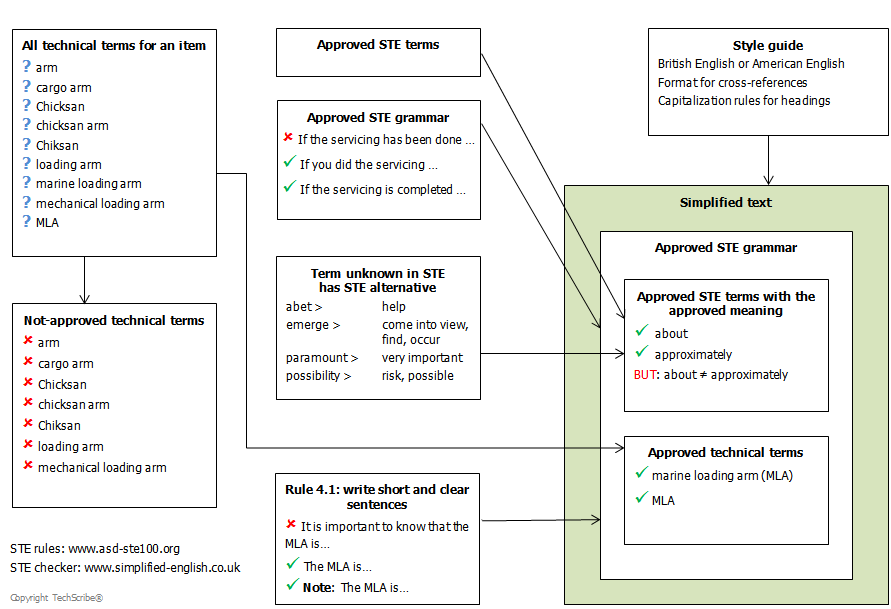ASD-STE100 Simplified Technical English
Plain English is not sufficient for many technical documents. A controlled language is a solution to the problems of plain English. A controlled language specifies the grammatical structures and the words that a writer can use. One controlled language is ASD-STE100 Simplified Technical English (www.asd-ste100.org).
The specification for ASD Simplified Technical English is ASD-STE100. (Before 2005, ASD Simplified Technical English was AECMA Simplified English.) ASD-STE100 was developed for the aerospace industry, but it can be adapted for other industries. ASD-STE100 helps people to write clear documentation.

ASD-STE100 contains these parts:
- A dictionary of words and their meanings
- A set of rules for writing.
The dictionary contains a list of words that you can use. For example, you can use 'make sure', but you cannot use synonyms such as 'verify', 'check', 'confirm' or 'ensure'.
Usually, each word is permitted for only one part of speech. For example, the word 'oil' is specified as a noun. Therefore, the word 'oil' must not be used as a verb:
- 'Oil the valve' is not permitted, because in this sentence 'oil' is a verb.
- 'The oil is dirty' is permitted, because in this sentence 'oil' is a noun.
Each word has only one meaning. For example, the verb 'to follow' means 'to come after'. 'To follow' does not mean 'to obey'. As an alternative to 'Follow the safety instructions', write 'Obey the safety instructions'.
The writing rules specify the structure of the text. For example, descriptive sentences must have no more than 25 words. (This rule puts a number on the plain English guideline to keep sentences short.)
Tenses are restricted. For example, you cannot use the present perfect tense. As an alternative, write the sentence in the simple past tense:
- 'We have received the technical reports from HQ' is not permitted, because the sentence uses the present perfect tense.
- 'We received the technical reports from HQ' is permitted, because the sentence uses the simple past tense.
Each industry has its own special vocabulary. Therefore, ASD Simplified Technical English lets you create a dictionary of approved verbs and approved nouns.
Simplified English: for and against
In technical documentation, ambiguous text is bad. Each instruction must be clear. ASD Simplified Technical English helps technical writers to achieve that requirement. ASD Simplified Technical English has limits, but it helps to make sure that text is clear.
Can we use ASD Simplified Technical English (or some other simplified English) for marketing texts?
The TechScribe website does not conform to all the rules of ASD-STE100. For example, we use synonyms such as 'technical writer' and 'technical author'. This website is a marketing tool. If people use the term 'technical author' in search engines, and if our term is 'technical writer', then people will not find this website. Therefore, we use the synonyms.
But, the TechScribe website conforms to most rules of ASD-STE100. Thus, the website is clear to people who do not read English well, and readers can use machine translation.
An alternative opinion
Some professional technical writers think that synonyms are good. In 'Spring into Technical Writing for Engineers and Scientists' (www.informit.com/store/product.aspx?isbn=0131498630), Barry Rosenberg suggests that for non-technical verbs, a technical writer can use synonyms to make the text interesting. I asked Barry to explain, and he wrote:
When I refer to a product name, a product component, a scientific concept, or any sort of technical noun, I want to make sure that I refer to this thing in the same consistent way each time. Thus, a "widget" on page 10 cannot become a "gadget" on page 11 and a "doohickey" on page 12. Such name shifts confuse readers. Similarly, if the correct technical verb for the way a widget disintegrates is "to framboozle," then I better make sure that the widget framboozles at every opportunity, even if the widget has to framboozle in sentence after sentence. However, in the "Verbs" section, I was trying to say (unsuccessfully, it would seem) that some writers tend to overuse certain general verbs (for example, "illustrates" or "shows"). For instance, a paragraph that used "shows" in four consecutive sentences would probably be a suboptimal paragraph. In this instance, I think verb variety can be quite helpful.
Language checkers for ASD-STE100
These language checkers help technical writers to make sure that text conforms to ASD-STE100:
- TechScribe term checker for ASD-STE100 (www.simplified-english.co.uk)
- Acrolinx rules for 'Simplified Technical English (ASD-STE100)' (https://support.acrolinx.com/hc/en-us/articles/10210995127698-STE-Simplified-Technical-English)
- ARDOS Checker (www.tdds-gmbh.de/index.php/en/software-products/ardos/ardos-checker)
- Boeing Simplified English Checker (BSEC) (www.boeing.com/company/key-orgs/licensing/simplified-english-checker)
- Congree Simplified Technical English Checker (www.congree.com/en/product/simplified-technical-english/)
- HyperSTE–AI-powered Content Quality Checker includes a checker for ASD-STE100 (https://hyperste.ai/)
- MAXit is a checker for controlled English. MAXit has a checker for Simplified Technical English (https://smartny.com/SimplifiedEnglish.html)
- MY-STE-BUDDY (https://my-ste-buddy.com)
- Oxygen Terminology Checker has an add-on for ASD Simplified Technical English Specification (ASD-STE100) Rules (https://www.oxygenxml.com/terminology-checker-addon-extra.html)
- R4i Writer has an optional Simplified Technical English (STE) Module (www.pennantplc.com/wp-content/uploads/2024/09/R4i-Technical-Brochure-2024.pdf)
- Reqchecker™ has a plugin: ASD-STE100 SILC™ automatic checker solution (https://reqchecker.eu/plugin-simplified-english/)
- TWEET (Technical Writing Efficiency Enhancement Tool) includes a checker for ASD-STE100 (www.umlaut.com/en/tweet).
Free language checkers for ASD-STE100
- Online Verb Checker for the ASD-STE100 Specification (https://globaltech-translations.com/ste/ste-checker.php)
- STE-checker tool (https://www.eluxis.com/simplified-technical-english-ste/)
- Thumbs Up STE Tool (https://instrktiv.com/ste/)
See also ![]()
![]() Advantages and disadvantages with Simplified Technical English, Karin Disborg (https://liu.diva-portal.org/smash/get/diva2:16816/FULLTEXT01)
Advantages and disadvantages with Simplified Technical English, Karin Disborg (https://liu.diva-portal.org/smash/get/diva2:16816/FULLTEXT01)
ASD, Aerospace and Defense Industries Association of Europe (www.asd-europe.org)
International English pages on the TechScribe website
The case for ASD-STE100 Simplified Technical English, Unwalla and Dodd, in Current Practices and Trends in Technical and Professional Communication (https://istc.org.uk/homepage/publications-and-resources/istc-books/current-practices-and-trends-in-technical-and-professional-communication/)